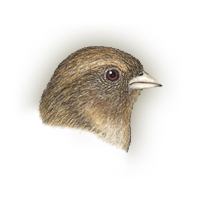|
Field
Guide IDs: BREEDING:
Chaparral, riparian
thickets, brushland, arid scrub, and around human
habitations. 2 or 3 broods. DISPLAYS:
Courting male
approaches female with wings drooped and quivering.
Male and female "squeal duet" and posture when
meeting after being apart within their
territory. NEST:
Bulky, of forb
stems, twigs, grass, inner bark, lined with fine
materials. EGGS:
Bluish-white,
marked with brown, purple. 1.0" (25 mm). DIET:
Young fed 100%
insects. Drinks morning dew from grass. CONSERVATION:
Winter resident.
Uncommon cowbird host (both species). Has spread
and increased in abundance as favored edge-type
habitat increased through grazing, logging,
farming, and suburbanization. NOTES:
Far w populations
highly territorial and males aggressively defend
against intruders, and reflections in windows and
hubcaps! E populations evidence little territorial
interaction and appear more peaceable. Female does
not flush easily from nest. "Mouse-runs" like other
towhees. Young remain with parents 4-6 weeks;
driven from territory when next clutch hatches.
Differences in behavior, vocalizations, and
genetics indicate that populations in CA and OR are
distinct from populations e of CA, and are now
considered separate species. Formerly called Brown
Towhee as was Canyon Towhee. Common resident in
a variety of habitat types virtually throughout
campus. More common and widespread than the Spotted
Towhee, foraging more frequently in open habitats
and farther from cover than the Spotted. Probably
the species most frequently parasitized by the
Brown-headed Cowbird on campus. ESSAYS: Walking
vs. Hopping;
Territoriality;
Species
and Speciation;
Drinking;
Range
Expansion REFERENCES:
Zink,
1988. |
